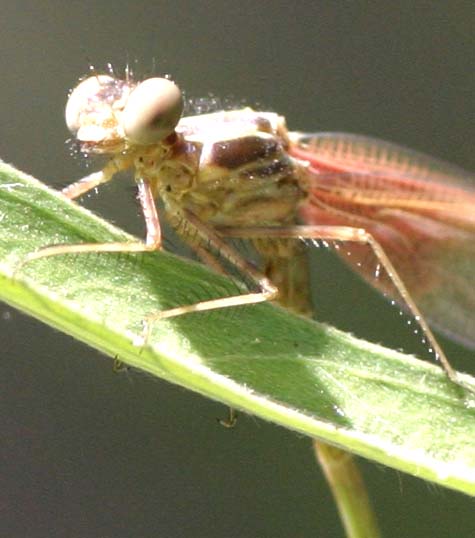| |
|
|
|
AMERICAN
RUBYSPOT
|
|
Hetaerina
americana
|
|
|
|
photo (above)
15 July 2006 Arroyo Seco River
photo (below) 9 Sep 2006 San Antonio River
|
| American Rubyspot is a large and showy damselfly
that is common along rushing streams in montane Monterey County. It is
easily recognized by its size (2.5 inches long) and scarlet red patches
at the base of each wing. Males are typically found sitting on rocks or
logs in the middle of a stream, wing-flicking for females. Although
colorful, they can be fairly inconspicuous against the dark running
water (below). |
|
|
| Females (right & below) are less showy.
The body lacks the rich metallic iridescence of the male, and the
reddish base of the wings is less dense in color. But the females do
have a cool combination of pale stripes on purplish body. Both sexes
have
extremely long leg spines. |
 |
|
|
|
|
photo (head shot,
above) 30 Aug 2006 Arroyo Seco River
photo (full body, above) 4 Sep 2006 Arroyo Leon, Fresno Co.
|
|
|
As rubyspots are common and
widespread, one may encounter portions of their life cycle that are not
often seen. An example might include exuvia (left) – the left-over
shell when the adult metamorphosed from the last nymph instar.
photo
(left) 15 July 2006 Arroyo Seco River
photo (below) 19
July 2006 Laguna Grande
|
|
|
|
| American Rubyspot appears to be widespread in
quick-flowing streams throughout the MTY foothills, but they have also
been found at unexpected locations along the coast. There is a Sep 1949
record from Big Sur. The male photographed above was at Laguna Grande
park, Seaside, less than a mile from the coast. |
|
 The map shows a selection of representative
locales at which American Rubyspot has been encountered. There are 16
specimens from Hastings NHR (presumably mostly from Finch Creek)
between July and mid-Aug, collected between 1938 and 1943. It was
common on the Salinas River, south of San Ardo, on 1 Sep 1977 (Dennis
Paulson), and can be almost abundant on the Arroyo Seco, in season
(esp. July-Sep). The map shows a selection of representative
locales at which American Rubyspot has been encountered. There are 16
specimens from Hastings NHR (presumably mostly from Finch Creek)
between July and mid-Aug, collected between 1938 and 1943. It was
common on the Salinas River, south of San Ardo, on 1 Sep 1977 (Dennis
Paulson), and can be almost abundant on the Arroyo Seco, in season
(esp. July-Sep).
MTY records span 28 Apr-7 Oct. Elsewhere in
California, the species has a long flight season from February to
November (Manolis 2003).
|
|
|
Literature cited:
- Manolis, T. 2003. Dragonflies and Damselflies of
California. Univ. of
Calif.
Press, Berkeley.
Web resources:
Major identification web sites with much information on California
odes include:
For sites with excellent photos to compare for identification or to
simply
enjoy, see:
Many of these sites have links to other useful pages. Kathy Biggs's
site
is particularly useful in her selection of links. |
|
All photos © Don Roberson 2007
TOP
|
|
|
Page created 11 Mar 2007,
revised 16 May 2007
|
|
|
|
|
